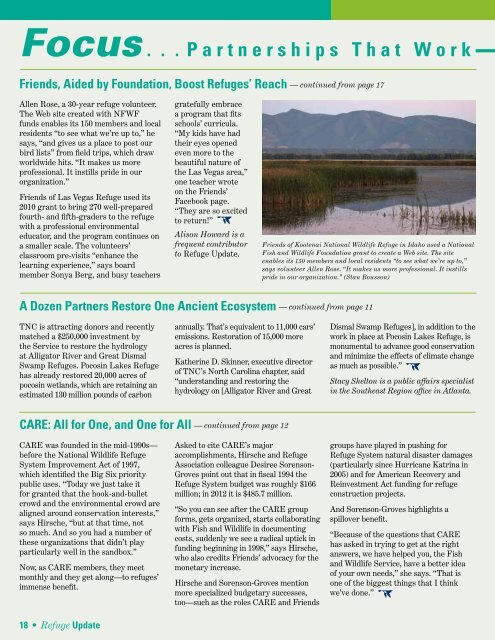Refuge Update - U.S. Fish and Wildlife Service
Refuge Update - U.S. Fish and Wildlife Service
Refuge Update - U.S. Fish and Wildlife Service
You also want an ePaper? Increase the reach of your titles
YUMPU automatically turns print PDFs into web optimized ePapers that Google loves.
Focus . . . PP a r t n e r s h i p s T h a t W o r k<br />
Friends, Aided by Foundation, Boost <strong>Refuge</strong>s’ Reach — continued from page 17<br />
Allen Rose, a 30-year refuge volunteer.<br />
The Web site created with NFWF<br />
funds enables its 150 members <strong>and</strong> local<br />
residents “to see what we’re up to,” he<br />
says, “<strong>and</strong> gives us a place to post our<br />
bird lists” from field trips, which draw<br />
worldwide hits. “It makes us more<br />
professional. It instills pride in our<br />
organization.”<br />
Friends of Las Vegas <strong>Refuge</strong> used its<br />
2010 grant to bring 270 well-prepared<br />
fourth- <strong>and</strong> fifth-graders to the refuge<br />
with a professional environmental<br />
educator, <strong>and</strong> the program continues on<br />
a smaller scale. The volunteers’<br />
classroom pre-visits “enhance the<br />
learning experience,” says board<br />
member Sonya Berg, <strong>and</strong> busy teachers<br />
18 • <strong>Refuge</strong> <strong>Update</strong><br />
gratefully embrace<br />
a program that fits<br />
schools’ curricula.<br />
“My kids have had<br />
their eyes opened<br />
even more to the<br />
beautiful nature of<br />
the Las Vegas area,”<br />
one teacher wrote<br />
on the Friends’<br />
Facebook page.<br />
“They are so excited<br />
to return!”<br />
Alison Howard is a<br />
frequent contributor<br />
to <strong>Refuge</strong> <strong>Update</strong>.<br />
Friends of Kootenai National <strong>Wildlife</strong> <strong>Refuge</strong> in Idaho used a National<br />
<strong>Fish</strong> <strong>and</strong> <strong>Wildlife</strong> Foundation grant to create a Web site. The site<br />
enables its 150 members <strong>and</strong> local residents “to see what we’re up to,”<br />
says volunteer Allen Rose. “It makes us more professional. It instills<br />
pride in our organization.” (Stan Bousson)<br />
A Dozen Partners Restore One Ancient Ecosystem — continued from page 11<br />
TNC is attracting donors <strong>and</strong> recently<br />
matched a $250,000 investment by<br />
the <strong>Service</strong> to restore the hydrology<br />
at Alligator River <strong>and</strong> Great Dismal<br />
Swamp <strong>Refuge</strong>s. Pocosin Lakes <strong>Refuge</strong><br />
has already restored 20,000 acres of<br />
pocosin wetl<strong>and</strong>s, which are retaining an<br />
estimated 130 million pounds of carbon<br />
annually. That’s equivalent to 11,000 cars’<br />
emissions. Restoration of 15,000 more<br />
acres is planned.<br />
Katherine D. Skinner, executive director<br />
of TNC’s North Carolina chapter, said<br />
“underst<strong>and</strong>ing <strong>and</strong> restoring the<br />
hydrology on [Alligator River <strong>and</strong> Great<br />
CARE: All for One, <strong>and</strong> One for All — continued from page 12<br />
CARE was founded in the mid-1990s—<br />
before the National <strong>Wildlife</strong> <strong>Refuge</strong><br />
System Improvement Act of 1997,<br />
which identified the Big Six priority<br />
public uses. “Today we just take it<br />
for granted that the hook-<strong>and</strong>-bullet<br />
crowd <strong>and</strong> the environmental crowd are<br />
aligned around conservation interests,”<br />
says Hirsche, “but at that time, not<br />
so much. And so you had a number of<br />
these organizations that didn’t play<br />
particularly well in the s<strong>and</strong>box.”<br />
Now, as CARE members, they meet<br />
monthly <strong>and</strong> they get along—to refuges’<br />
immense benefit.<br />
Asked to cite CARE’s major<br />
accomplishments, Hirsche <strong>and</strong> <strong>Refuge</strong><br />
Association colleague Desiree Sorenson-<br />
Groves point out that in fiscal 1994 the<br />
<strong>Refuge</strong> System budget was roughly $166<br />
million; in 2012 it is $485.7 million.<br />
“So you can see after the CARE group<br />
forms, gets organized, starts collaborating<br />
with <strong>Fish</strong> <strong>and</strong> <strong>Wildlife</strong> in documenting<br />
costs, suddenly we see a radical uptick in<br />
funding beginning in 1998,” says Hirsche,<br />
who also credits Friends’ advocacy for the<br />
monetary increase.<br />
Hirsche <strong>and</strong> Sorenson-Groves mention<br />
more specialized budgetary successes,<br />
too—such as the roles CARE <strong>and</strong> Friends<br />
Dismal Swamp <strong>Refuge</strong>s], in addition to the<br />
work in place at Pocosin Lakes <strong>Refuge</strong>, is<br />
monumental to advance good conservation<br />
<strong>and</strong> minimize the effects of climate change<br />
as much as possible.”<br />
Stacy Shelton is a public affairs specialist<br />
in the Southeast Region office in Atlanta.<br />
groups have played in pushing for<br />
<strong>Refuge</strong> System natural disaster damages<br />
(particularly since Hurricane Katrina in<br />
2005) <strong>and</strong> for American Recovery <strong>and</strong><br />
Reinvestment Act funding for refuge<br />
construction projects.<br />
And Sorenson-Groves highlights a<br />
spillover benefit.<br />
“Because of the questions that CARE<br />
has asked in trying to get at the right<br />
answers, we have helped you, the <strong>Fish</strong><br />
<strong>and</strong> <strong>Wildlife</strong> <strong>Service</strong>, have a better idea<br />
of your own needs,” she says. “That is<br />
one of the biggest things that I think<br />
we’ve done.”

















